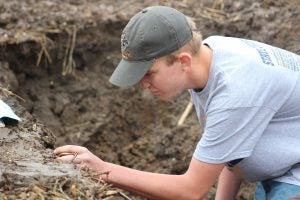Iowa FFA is on the up and up … literally. Their 2016-2017 membership, with 233 chapters and 14,923 members, is the highest membership the Hawkeye state has ever seen.
Iowa FFA Executive Secretary Scott Johnson believes there are many outside factors that have contributed to the state’s boost in membership.
“The strength of the agriculture industry during the 07-08 economy and the prospect of 9.3 billion people on this planet by 2050 have emphasized the demand and opportunity for careers in ag. That, complemented with Iowa STEM grants for CASE, have supported this growth trend as well,” Johnson said. “Thus, there has been an increase in enrollment per program (about 10 percent) and an increase in the number of programs (FFA Chapters) in Iowa by 5 percent in the last 10 years.”
To put Iowa FFA’s numbers in perspective, enrollment for 1990-1991 was 8,722 members – the lowest membership since 1951-1952. Twenty-six years later it’s a completely different playing field.
“There are vast opportunities in agriculture that go beyond production. Thus, students who don’t come from a production agriculture background see and are interested in the entire food, fiber, and energy system,” Johnson said. “With the continued push of STEM concepts in Ag Ed programs, we think this trend of student population and involvement will continue.”
It’s also been a boots-on-the-ground approach.
“We as a state officer team do our best to encourage involvement on the local level. One opportunity we have as officers is to visit our local chapters at some of their events and also by leading workshops at their school. Through this experience, we get to meet a wide array of agricultural education students from all backgrounds and experiences,” said Zach Hamilton, Iowa FFA State President. “This allows us to share our stories as well as the stories of other outstanding FFA members that we have met and help to show Ag Ed students, (and everyone for that matter), that there is a place for them within the FFA.”

In fact, one of the Iowa state FFA team goals this year is to “reach out to chapters which haven’t had interactions with state officers within the past three years” as well as “diversify the means by which they interact with chapters.” Their focus this year is the members and how as an officer team they can continue to help the organization continue to provide an opportunity for personal growth.
“The local programs do all of the legwork as far as recruitment and retention goes, we just serve as a support for those programs when they need it,” Hamilton said. “We wouldn’t be able to do much of anything with members if it weren’t for the local program reaching out and allowing us to visit and interact with members.”
It’s a local effort, but also not necessarily a rural effort. More than 65 percent of Iowa FFA members do not even come from a farm.
“In my opinion, our greatest opportunity for programs in urban areas will come from stakeholders within those respective school districts partnering with their policy makers (school board and administration) to make it happen. FFA is a part of the three circle model of Ag Education,” Johnson said. “Therefore, FFA is not a club, it can only exist in the presence of an Agricultural Education Department within a school system. This is a significant commitment by any school district and we are grateful for those who have made the commitment to offering these opportunities to their students.”
Hamilton also said Iowa FFA isn’t doing anything better than any association. He said the state FFA is constantly learning from other associations, finding ways to support chapters and members that worked for other states, and seeing if it’s possible to apply at home.
But the reality is ag isn’t going away and Iowa FFA has done a great job conveying that to students.
“Are you into computers and programming? Companies like John Deere would love to have you in order to continue finding new ways to integrate technology to improve on agricultural practices such as data-based decision making or creating the next high-tech machinery. Are you more of a people person? Every company is looking for people to help them share the message not only of their company but also of agriculture. Are you into science and see yourself working in a lab to solve a current problem? There are plenty of research opportunities within agriculture to improve on how we go about growing our food and other resources,” Hamilton said. “You are guaranteed to find a place within agriculture, and a successful career at that, no matter what your background is. We as members recognize this and want to be a part of that success.”



